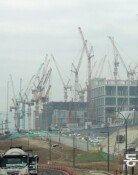Bigger Blow to Low Income Earners with Uniform Housing Loan Regulations
Bigger Blow to Low Income Earners with Uniform Housing Loan Regulations
Posted January. 23, 2007 07:05,
Research finding has revealed that as the size of the housing-backed loans for the lowest income bracket amounts to 3.3 times that of the annual income, stringent regulations on housing loans will deliver the hardest blow to the low income earners. In addition, concerns were raised that increased interest in curbing housing prices could reduce industrial production.
According to the document Establishment of the Basic Models to Monitor the Risks in the Housing Finance Market written by the Financial Supervisory Service and obtained by the Dong-A Ilbo on January 22, the size of the housing loans vis-à-vis the income in 2006 for 10 income brackets was the highest among the lowest income bracket or the lowest 10 percent (based on the housing units categorized according to income levels, starting from the lowest 10 percent), reaching 3.3 times that of the income.
The average annual income of the lowest group last year was 10.75 million won while the average housing loans for the same group were estimated to be 35.48 million won.
The share of the housing loan versus the annual income for other income brackets was 2.7 times for the second bracket of 10 percent, 2.2 times for the fourth bracket, 2.0 times for the sixth bracket, and 1.9 for the eighth, showing a decrease proportional to the higher income levels.
As for the high income brackets above the eighth bracket, the share of the housing loans was less than two times, while the top income earners or the 10th bracket (the top 10 percent) was a magnitude of 1.8 times, showing the lowest level along with the seventh bracket.
The average housing loans for the top income bracket amounted to 169.7 million won, but their annual income of 94.28 million won was less of a burden compared to the low income earners.
In particular, the lowest income bracket spent most of their housing loans on purchasing homes, so stricter loan regulations would stifle them in financing a house purchase, and push them to sell it when housing prices plummet.
Whats worrisome is the fact that the low income brackets will become the biggest victims of the loan regulations as well as possible risks of plummeting housing prices compared to their counterparts. The document also predicted that increases in the call rate set by the Bank of Korea would lead to temporary drops in housing prices and reduced housing loans, along with side effects including reduction in corporate production volumes.
At the same time, it revealed the findings overturned the previous argument made by financial authorities claiming that the increases in housing loans led to the housing price hike, with housing loans increasing following the housing price hike.
Professor Seo Seung-hwan (of economics) of Yonsei University said, Loan regulations wreck direct havoc on some income brackets in their effort to pay back their debt, harming the overall economy, adding, There is a need to ease the intensity of the loan regulations for single-house owners and borrowers with below-average priced houses.
legman@donga.com







